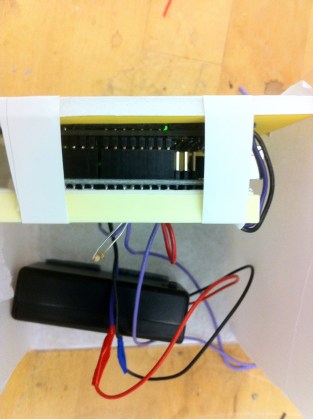Josef Ayala-Tell Tale Heart Box Iteration 2 and 3. Final Pieces (Hat Piece/Tell Tale Heart).
Iteration 2:
So, I made a second iteration of the “Tell Tale Heart” box, but it really wasn’t anything to write home about. It essentially utilized the same components of its black Styrofoam counterpart (the list can be found below the picture). That said, the difference is that I made the enclosure by hand from spare pieces of balsa wood. I drew the floorboards on it, and hot glued them together to make the box you see. In this iteration I also drew a figure and cut him out by hand using an X-acto blade. Afterwards, I attempted to make a smooth popping transition for the solenoid by using sand paper to round out the edges (or in some instances remove tight pieces of balsa wood left over from the cutting). Overall, I was not happy with the end product as the figure moved sluggishly and would even get caught in the floor it was attempting to pop out of. In the end, this box was destroyed before I could even video tape it. Needless to say it needed a lot of work.
Project 1 (Tell Tale Heart Box-3rd and Last Iteration):
Description: The Tell Tale Heart Box was my rendition of a scene from Edgar Allen Poe’s short story. It essentially uses the pulse sensor to generate your heart beat and apply it to a solenoid that pushes the floor board up and down (simulating a live pulse and recreating the paranoia felt by the story’s protagonist that in turn causes him to turn himself in to the authorities stopping by his home). In this iteration, I decided to go a for a smaller prototype by starting with a draw bought from the container store (to break myself out of the habit of making 8 by 8 boxes). The box was altered in the sense that it has balsa wood pieces glued to the bottom of it to raise it a few centimeters off the ground or table. The reason for this is because the solenoid was too tall for the enclosure. To compensate, I had a hole laser cut in one part of the box that was big enough to fit the retracted coil when the solenoid was pumping/pulling. Aside from that this circuit had not changed much. Another great aesthetic difference was that the floor boards were not laser etched in balsa wood and cut for the purpose of fitting into the new drawer enclosure. Another box was cut out of this with the laser cutter and glued to the top of the solenoid so that it could be pushed upward simulating a heart beat under the floor board.
Heart Box uses:
-Pulse Sensor (glued on the backside and ready for use on the back side of the box).
-Solenoid (glued in the center of the box for vertical stance with a floor board glued to the pin).
-3 9V batteries (2 for the solenoid/1 for the Arduino board)
- Bread Board/Arduino Uno/Jumper Cables etc.
Feedback: Feedback was well received for this product. I was told to explore the options of sound and other effects to make it more realistic. It was also suggested that I could get the solenoid to act in real time with Pulse Sensor. How? Mystery to me, but I’m interested in finding out more. I imagine there is some sort of way to set up the solenoid with a faster reaction.
CODE CAN BE FOUND IN MY PREVIOUS POST HERE.Project 2 (Wake-Box:Final Iteration):
How do you improve on a classic?
Description: This project is comprised of an Arduino UNO board, an LoL Shield, and a tilt sensor. Using the tilt sensor when it is attached to a baseball cap should reflect when I am asleep. My head hanging down should show that the tilt sensor is ON and beginning the scrolling text which says “WAKE ME UP AT 96TH STREET”. When someone sees this they will ideally wake me up and when I lift my head the tilt sensor would tilt OFF and stop creating the Scrolling Text. The premise for this project is that it would be used in the train station during my evening commute to help me NOT miss my stop at 96th street..
This iteration saw a better implementation for my enclosure. Previously the paper set up on my project was a bit ratty looking with patches and holes missing. I also managed to tape the screen one face of the box (using 1lb resistant removable gel tiles). I was always proud of this project and found it was a good exploration into the use of PComp in an Instruction Set For Strangers format. It was also a great way to see if people would actually wake me up. It should be noted that this project is not meant for retail but rather some sort of performance art.
CODE CAN BE FOUND IN MY PREVIOUS POST HERE.




















Reply